Heteroteuthis
Richard E. Young, Clyde F. E. Roper, and Katharina M. Mangold (1922-2003)


This tree diagram shows the relationships between several groups of organisms.
The root of the current tree connects the organisms featured in this tree to their containing group and the rest of the Tree of Life. The basal branching point in the tree represents the ancestor of the other groups in the tree. This ancestor diversified over time into several descendent subgroups, which are represented as internal nodes and terminal taxa to the right.

You can click on the root to travel down the Tree of Life all the way to the root of all Life, and you can click on the names of descendent subgroups to travel up the Tree of Life all the way to individual species.
For more information on ToL tree formatting, please see Interpreting the Tree or Classification. To learn more about phylogenetic trees, please visit our Phylogenetic Biology pages.
close boxIntroduction
Species of Heteroteuthis are the most oceanic members of the subfamily. They are capable of producing brilliant luminescence from their bacterial photophore or secreting luminescent clouds, in a variety of forms, from it. Their large visceral photophore is seen in the left photograph below with the mantle cut open; a closer view is seen to the immediate right. The two large pores on the photophore surface enable the luminescent material to be extruded from the underlying glands. The heavy covering of iridophores that provide the variety of colors seen in the photographs appear to act as a color filter and shutter for the bioluminescence. Other members of the subfamily presumably have similar luminescent capabilities but they have not been observed.
Figure. Left - Ventral view of H. hawaiiensis with the ventral mantle removed, female, Hawaiian waters. Middle - Close-up view of the same photophore. Left - See-through side view of H. hawaiiensis showing relationship between the ink sac, which surrounds the back of the photophore, the photophore and the ventral mantle shield which may act as a diffuser of the bioluminescence. Photographs by R. Young; drawing modified from Young (1977).
Brief diagnosis:
A heteroteuthin with ...
- ventral mantle shield confined to anterior half of mantle.
- fins attached posteriorly on mantle.
Characteristics
- Arms
- Right arm I and II hectocotylized in males (see photograph): arm bases bare and fused; area of fusion holds single large gland; right arm II broadened proximally and bordered by glands. These modifications absent in H. ryukyuensis.
- Each arm III in males with two or three greatly enlarged suckers.
- Some arms in females with bare tips except, apparently, in H. ryukyuensis.
Figure. Oral view of arms I-III of a mature female H. dagamensis showing bare tips of arms I and II . Drawing by A. Hart.
- Right arm I and II hectocotylized in males (see photograph): arm bases bare and fused; area of fusion holds single large gland; right arm II broadened proximally and bordered by glands. These modifications absent in H. ryukyuensis.
- Funnel
- Funnel locking-apparatus with deep, curved groove.
- Funnel locking-apparatus with deep, curved groove.
- Mantle
- Dorsal mantle margin free from head; nuchal cartilage free.
- Ventral mantle shield confined to anterior half of mantle.
- Fins
- Fin length much less than mantle length.
- Fins attach on posterior half of mantle.
- Posterior fin lobes rounded.
Comments
Three named species are presently recognized in the genus, H. dispar (type species, type locality - Mediterranean Sea), H. hawaiiensis (type locality - off the Hawaiian Islands), and H. dagamensis (type locality- off South Africa). H. ryukyuensis (type locality - Ryukyu Archipelago east of Taiwan. H. dispar and H. hawaiiensis are very similar but specimens have never been directly compared. As a result, reliable characters to separate them are unknown.
| Single greatly enlarged sucker on Arm IV | Bare arm tips, females | Greatly enlarged arm III suckers, males | Funnel locking-apparatus | Right arms I and II hectocotylized | |
| H. dispar | No | Arms I & II | In dorsal and ventral series | Deep, curved groove | Yes |
| H. hawaiiensis | No | Arms I & II | In dorsal and ventral series | Deep, curved groove | Yes |
| H. dagamensis | No | Arms I & II | In dorsal series | Deep, curved groove | Yes |
| H. ryukyuensis | Yes | No bare tips (?) | In dorsal and ventral series | Deep, curved groove | No |
Table characters:

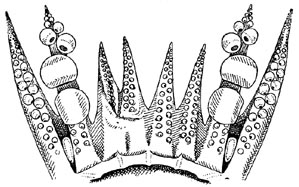
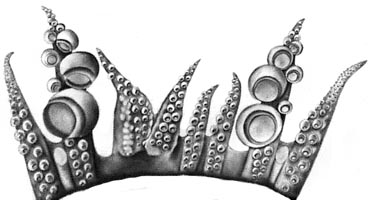
Figure. Left - Oral view of the arm crown of H. dispar, Mediterranean Sea, male. The third arms each bear two greatly enlarged suckers which are aligned in the drawing but actually one member is in the dorsal series and the other in the ventral series. Drawing from Naef (1921-23). Right - Oral view of the arms of a mature male Heteroteuthis dagamensis. Note that the greatly enlarged suckers are in the dorsal series and clearly alternate with smaller suckers in the ventral series. Drawing by A. Hart.
Distribution
Geographical
Circumglobal in tropical to warm temperate oceans.
Vertical
During the day in Hawaiian waters, H. hawaiiensis less than 17; mm ML were taken mostly between depths of 250 and 350 m; squid larger than 17 mm ML were taken at greater depths of 375-650. During the night squid less than 17 mm ML were mostly taken between depths of 150 and 200 m; larger squid were taken between depths of 110 and 550 m. Males and females mature around 15-16 mm ML. In Hawaiian waters the Mesopelagic Zone begins at about 400 m during the day (Young, 1983).

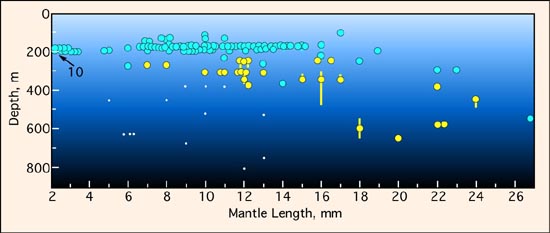
Figure. Chart of the vertical distribution of H. hawaiiensis from Hawaiian waters, taken with both opening/closing and open trawls. Large blue dots - Night captures. Large yellow dots - Day captures. Small dots - Presumed contaminents from deep open tows. Dots represent the modal depth of the trawl regardless of trawl type. Bars with dots - Trawl fishing-range of open/closing trawls. Chart modified from Young (1977).
As far as is known, sepiolids lay their eggs on the ocean floor. Species of Heteroteuthis are the most oceanic members of the family. Nevertheless, evidence suggests that they also spawn on the ocean floor at moderate depths. Nesis (1993) found them, although broadly distributed in the open ocean, more common near seamounts and submarine ridges. Boletzky (1978) described an embryo of H. dispar that had been collected in an open bottom trawl (Mediterranean Sea, 540 m depth) and presumably had been collected on the ocean floor. Okutani and Tsuchida (2005) reported numerous mature females of H. hawaiiensis on the ocean floor at a depth of 912 m near the Ogasawara Islands.

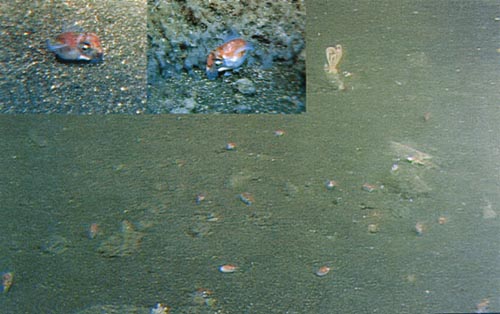
Figure. Video images of H. hawaiiensis on the ocean floor taken by the ROV Hyper-Dolphin operated from the R/V NATSUSHIMA of the Japan Agency for Marine-Earth Science and Technology (JAMSTEC) on the gentle slope of Kaikata Seamount (26°41.25'N, 141°02.72'E) at a depth of 912 m (Okutani and Tsuchida, 2005). Inserts on the upper left show two individuals swimming near the bottom. The larger image shows more than a dozen individuals swimming near the bottom.
References
Nesis, K. N. 1993. Cephalopods of seamounts and submarine ridges. In: T. Okutani, R. K. O'Dor and T. Kubodera (eds.). The Recent Advances in Cephalopod Fishery Biology. Tokai University Press. Tokyo, pp. 365-373.
Okutani, T. and S. Tsuchida. 2005. Occurrence and living habit of bathyal bobtail squid, Heteroteuthis hawaiiensis (Cephalopoda: Sepiolidae) from off the dOgasawara Islands, Japan.
BOLETZKY, S. v. 1978 -- Premières données sur le développement embryonnaire du Sépiolide pelagique Heteroteuthis (Mollusca, Cephalopoda). Haliotis, 9: 81-84.
Young, R.E. 1977. Bioluminescent countershading in midwater cephalopods. Proc. Zool. Soc. Lond., No. 38:161-190.
Young, R.E. 1983. Oceanic bioluminescence: An overview of general functions. Bull. Mar. Sci., 33(4):829-845
Title Illustrations

| Scientific Name | Heteroteuthis hawaiiensis |
|---|---|
| Location | off Hawaii |
| Comments | shows the lateral silvery band on the mantle |
| Image Use |
 This media file is licensed under the Creative Commons Attribution-NonCommercial License - Version 3.0. This media file is licensed under the Creative Commons Attribution-NonCommercial License - Version 3.0.
|
| Copyright |
© 1996
Richard E. Young

|
| Scientific Name | Heteroteuthis dagamensis |
|---|---|
| Location | Off New Zealand, 40°04'S, 168°03'E |
| Creator | Allan Hart |
| Sex | Male |
| Life Cycle Stage | Mature |
| View | Side |
| Copyright |
©
Clyde F. E. Roper

|
| Scientific Name | Heteroteuthis hawaiiensis |
|---|---|
| Specimen Condition | Live Specimen |
| View | Dorsal-oblique |
| Image Use |
 This media file is licensed under the Creative Commons Attribution-NonCommercial License - Version 3.0. This media file is licensed under the Creative Commons Attribution-NonCommercial License - Version 3.0.
|
| Copyright |
©
Richard E. Young

|
About This Page
Richard E. Young

University of Hawaii, Honolulu, HI, USA
Clyde F. E. Roper

Smithsonian Institution, Washington, D. C., USA
Katharina M. Mangold (1922-2003)

Laboratoire Arago, Banyuls-Sur-Mer, France
Page copyright © 2017 Richard E. Young , Clyde F. E. Roper , and Katharina M. Mangold (1922-2003)
 Page: Tree of Life
Heteroteuthis .
Authored by
Richard E. Young, Clyde F. E. Roper, and Katharina M. Mangold (1922-2003).
The TEXT of this page is licensed under the
Creative Commons Attribution-NonCommercial License - Version 3.0. Note that images and other media
featured on this page are each governed by their own license, and they may or may not be available
for reuse. Click on an image or a media link to access the media data window, which provides the
relevant licensing information. For the general terms and conditions of ToL material reuse and
redistribution, please see the Tree of Life Copyright
Policies.
Page: Tree of Life
Heteroteuthis .
Authored by
Richard E. Young, Clyde F. E. Roper, and Katharina M. Mangold (1922-2003).
The TEXT of this page is licensed under the
Creative Commons Attribution-NonCommercial License - Version 3.0. Note that images and other media
featured on this page are each governed by their own license, and they may or may not be available
for reuse. Click on an image or a media link to access the media data window, which provides the
relevant licensing information. For the general terms and conditions of ToL material reuse and
redistribution, please see the Tree of Life Copyright
Policies.
- Content changed 02 May 2017
Citing this page:
Young, Richard E., Clyde F. E. Roper, and Katharina M. Mangold (1922-2003). 2017. Heteroteuthis . Version 02 May 2017 (under construction). http://tolweb.org/Heteroteuthis/20030/2017.05.02 in The Tree of Life Web Project, http://tolweb.org/




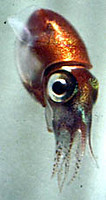
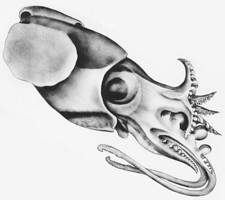
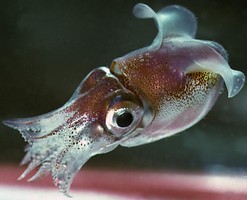
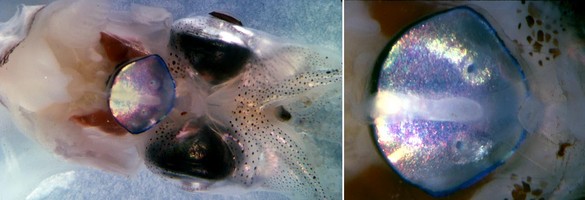
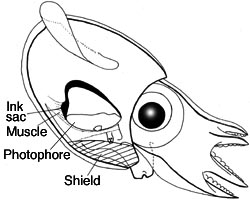
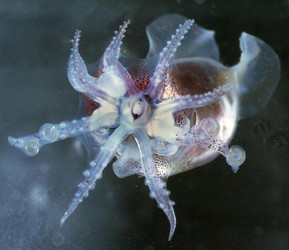
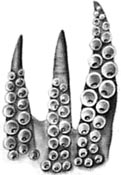
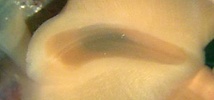

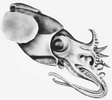
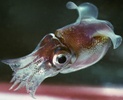

 Go to quick links
Go to quick search
Go to navigation for this section of the ToL site
Go to detailed links for the ToL site
Go to quick links
Go to quick search
Go to navigation for this section of the ToL site
Go to detailed links for the ToL site